| printer friendly | |||
|
|||
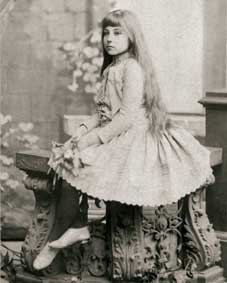 | |
| Helena Shaposhnikova. 1889 |
Helena Shaposhnikova belonged, through the maternal line, to the noble family of Golenischev-Kutuzovs. Her mother Ekaterina was a grandniece of great Russian general Mikhail Kutuzov. The family emblem and photographs of its glorious representatives are exhibited in one of the show-cases.
Here there are also photographs of little Helena and her parents. She was born in Saint-Petersburg, in the family of architect I. Shaposhnikov. The girl was endowed with outstanding abilities, at an early age, she already showed inclination for music, art, philosophy. She finished the Mariinsky Female Gymnasium and entered the Saint-Petersburg music school. She studied with enthusiasm and inspiration, beautifully played the piano. She easily perceived and understood the Indian philosophy. Most of the people who saw and knew her wrote about her intellect and kindness, subtlety and spiritual power emanating from her. Her thoughts, her vision, her subtlest feelings constituted the internal essence of that harmonious collaboration of people – a woman and a man, where Roerich himself, closely connected with this internal essence, represented primarily its external side. And this external side, as necessary as the internal, was implemented in his paintings, verses, fairy-tales.
Later, this collaboration would be extended. Two sons would appear: George and Svetoslav. And in each of them, in addition to their own individuality, those things that made the circle of interests of their parents would be embodied.
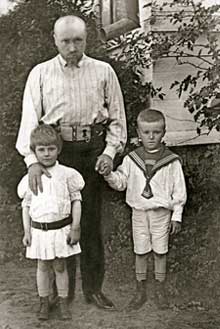 | |
| Nicholas, Svetoslav, and George Roerichs. 1908 |
But this would be in the future. And for the time being, the boys studied at the same May gymnasium which finished their father. The textbooks which they used in their studies can be seen in the hall. Nicholas and Helena Roerichs dedicated a lot of attention and time to education of their sons, inured them to diligence, observation, initiative. Creative atmosphere in the family, versatile interests of their parents formed bents and inclinations of the children.
In George, still in his gymnasium years, interest for the East, its culture and history was awakened. He studied with enthusiasm the history of Ancient Egypt and Babylon. Famous Russian Egyptologist B. Tourayev taught a special course to the boy. Gradually, George focused on the study of Asian countries, especially Mongolia, he studied the Mongolian language and literature under the supervision of Mongolianist A. Rudnev.
Svetoslav, or Svetik (Little Light), as they called him in the family, was interested in the life of nature. He raised collections of plants, stones, studied birds and insects. And this love for natural sciences would persist for his whole life.
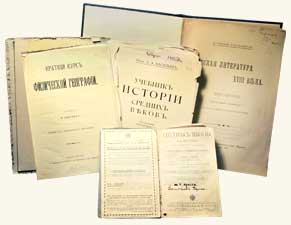 | |
| George and Svetoslav Roerichs’ textbooks |
Both the brothers painted a lot. They painted from nature landscapes and portraits, copied Dutch artists’ paintings from their father’s collection. The elder, George, would become a scientist-Orientalist with a worldly known name. He would speak more than 30 languages, Western-European and Oriental. But he also had a gift for painting. In the hall, there are George Roerich’s drawings performed by him at the age of 15 – 16. Medieval castles and fantastic chimeras, room interiors and unusual still-lives testify to the undisputable artistic talent of their author. Among George’s drawings, there is a small portrait of his father. With clean, laconic lines, the elder son conveys the internal power, concentration, some kind of amazing wisdom of Nicholas Roerich.
 | |
| G. Roerich. Portrait of N.К. Roerich. 1918 |
Belief in man, careful attitude towards his dignity, respect – this was the atmosphere in which the sons were growing and were educated. Love for their father and mother made one of the solid foundations of their life. Nicholas Roerich was not only a father and an instructor for them, but a Teacher in the highest sense of this word.
“Nicholas Roerich always placed the art of life higher than any other art, after many decades, the artist’s younger son Svetoslav Roerich would say. – He was not only a great painter. He was first of all a great artist of life. <…> I would say that Nicholas Roerich was an embodiment of achievements of many people taken together in a single whole. And sometimes it is difficult to imagine that one person could do so much as he did! <…> He always worked. Each moment of his life was creating”[14, p.65].
In 1906, N. Roerich got position of the director of a major art school of Russia – the School of the Society for Encouragement of Arts. Roerich’s energy and organizational abilities resulted in the fact that in a few years the School became one of the biggest democratic educational institutions of the country. Nicholas Roerich introduced to academic programs classes for general artistic education, music, choir singing, opened a network of the school suburban departments, workshops, and classes, affordable for the working youth. Under the School, a Museum of Russian Art was opened.
“This miracle happened thanks to the energy of one man, one artist – Roerich, who deserves more and more respect for that consistency with which he is fighting for live art against lifeless clichés and red-tape”, a famous arts critic A. Benois wrote in the article published in the newspaper of “Retch” (“Speech”) dated May 14, 1910.
Nicholas Roerich was a member of the Emperor’s Archeological Commission and many archeological societies of Saint-Petersburg. Busy as he was with his office affairs and archeology, the artist dedicated a lot of time to creative work. He painted church frescoes, painted the set and costume designs for theatre productions. His canvases revived the primeval magnificence of his country’s nature. A series of Russian landscape drawings is exhibited in the hall.
 | |
| N. Roerich. Conjuration of Fire. Sketch. Undated |
He created paintings on which the past came back to life – a distant epoch on Roerich’s canvases sounded with long gone voices, became filled with colors and shapes. But among concrete, recognizable paintings, unusual and strange canvases appeared. In one of the hall show-cases we see the sketch to the painting “Conjuration of Fire”. Tossing across uneven sooty ceiling of a secret cave shadow of a sorcerer, long tousle of hair, strewing over his naked shoulders… Some mystery arising from the “grey many-century haze” was entering the images captured by the artist on these amazing canvases. As if not the history was living in them, but legends about it.
Roerich’s fame was growing from year to year. Nicholas Roerich constantly took part in foreign exhibitions of Russian art. Paris, Venice, Berlin, Rome, Brussels, Vienna, London got acquainted with Roerich’s creative work. In 1909, an important event in the Master’s life happened – he was awarded the title of Academician of the Russian Academy of Arts and became a member of the Reim Academy in France.
At the beginning of 1915, Nicholas Roerich caught pneumonia in a grave form. The newspaper “Birzhevye Novosti” (“Stock Exchange News”) published a bulletin about the state of his health. That same year, the Russian public celebrated the artist’s creative work 25th anniversary. A. Blok sent him his congratulations: “From the bottom of my heart I congratulate my favorite strict master”. Multiple telegrams, congratulations from writers, scientists, painters were received. But Roerich himself was tortured with disturbing premonitions.
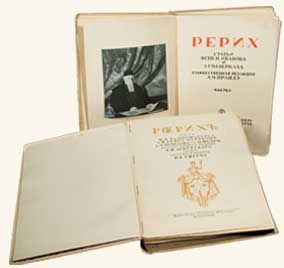 | |
| Monographs about N. Roerich. Publications of 1916 and 1939.
From the Roerich family library |
Shall I survive? Shall I be able
to test my sign
again acquired?[15, p.84]
His health approached a dangerous point. The doctors advised to change the climate, and in 1916, Nicholas Roerich with his family went to Serdobol (now Sortavala).
The disease did not subside for a long time. In this, the most difficult for Nicholas Roerich period, the publishing house “Svobodnoye Iskusstvo” (“Free Art”), to commemorate the artist’s creative work 25th anniversary, released in Petrograd the book “Roerich”, opening with it the series of monographs about workers of culture and art.
“Roerich is one of the dearest and close to the heart names in the Russian art, the publisher’s booklet said. – He opened slightly the doors to a mysterious kingdom; from the depths of the eternal stone, extracted a wonderful Russian fairy-tale. <…>
But Roerich is not only a painter, he is also a writer <…> That is why the reader will see ten fairy-tales and parables by Roerich in our edition”[16, p.296].
The response to the monograph “Roerich” reaching the family in Serdobol made them excited and happy. The monograph which was published in only five hundred numbered copies turned out to be so demanded that it was completely distributed by subscription. No single copy of the book came into the market.
In a beautifully illustrated huge volume, articles of critics and historians of art are collected: A. Benois, A. Guidoni, S. Yaremich, poet Y. Baltrushaitis, writer A. Remizov. The book, published in 1916 году, is exhibited in the hall.
And here there are also the books from the Roerichs’ personal library. They include books by H. Blavatskaya (Radda Bai), who opened India to a wide circle of readers at the end of the XIX century; creations of great philosophers of India Ramakrishna and Vivekananda; the Upanishads and Bhagavad-Gita – the book containing the ancient wisdom of India.
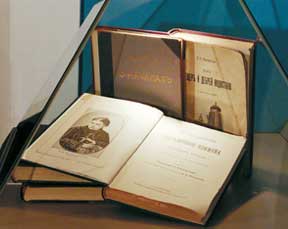 | |
| Show-case with books from the Roerich family library |
Already at the beginning of the 1900-s, Nicholas and Helena Roerichs got absorbed in the study of the culture and philosophy of India. The artist was absolutely convinced that it was necessary to bring closer the spiritual heritage of the East and the newest scientific search of Russia. He dreamed of establishing an Indian museum in Saint-Petersburg, he was going to send to India scholarship winners of the School of the Society for Art Encouragement, undertook steps directed at organization of a scientific research expedition. The starting war interfered with Roerich’s plans. But the Call of India was powerful and inevitable. There, in Karelia, in the middle of severe, silent nature of the North, it became closer and more distinct. The path was determined:
Get up, my friend. The message is received.
Your rest is over. <…>
Our way will be full of stones.
The East is getting light. It’s
time[17, p.42-43].
The time in which Roerich lived was very complicated. It was the Time of Changes: in February of 1917, the autocracy was overthrown, in October, the revolution took place, which determined a different fate for Russia. In 1918, Finland got independence and closed the border with Russia. The painter never came back to Saint-Petersburg. And not because he could not return. He would overcome more difficult borders in life. The problem was in something else. In those days, he faced a hard and, to a certain extent, tragic choice. The Call of India was strong, the expedition necessity became incontestable. He understood that he would not get to India from Soviet Russia. He was leaving his Motherland with which so much was connected for him. He was leaving it for India. This awareness did not make the parting easier.
<…> I go. I am in a hurry.
But one time, just one time –
the last time, I will go around everything that I
have left[18, p.49].
Foreign passports received by the Roerichs at the Russian Consulate in Sweden in 1918, are exhibited in the hall central show-case. The passports were issued to Russian citizens. With these passports they would live in England, America, China, Mongolia, Tibet, India.
Like a wanderer, the artist would pass all over the world, but the fire of his home will always burn for him in Russia. And many years after, Nicholas Roerich would write: “For the Russian people we worked. To it we are carrying the knowledge and achievements”[19, p.26].
|
|
||
|
||
